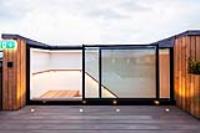 Add My Company
Add My Company
Sign In

Having outdoor living space is an important consideration for modern homes. With space often at a premium, especially in urban locations, a roof terrace will allow you to make the most of an otherwise unused area and provide a desirable outdoor space, perfect for entertaining, growing food or just enjoying the fresh air and sunshine.
When creating a roof terrace, there’s a lot to think about to ensure the space is safe, easy to access and meets the requirements of the homeowner. Here are some things to consider:
Roof type and structure
The type of roof will play a defining role in how the roof terrace is constructed.
Pitched roofs
For obvious reasons, a sloped roof is not an ideal candidate for a roof terrace. However, flat spaces can be created either by building up an external wall or cutting into the roof. Getting planning permission for this type of project can often be difficult.
Flat roofs
In most cases, an existing flat roof will be used to create a roof terrace. In concrete or steel frame buildings, the existing flat roof is likely to have enough structural strength for a terrace, because the roof is constructed like the floor structures below. Timber-framed residential constructions are much more likely to require upgrading. This will usually entail placing a steel joist underneath the roof structure.
Whatever type of roof the property currently has, a structural engineer will need to survey the property and drill inspection holes to determine how the roof has been built-up and what upgrades will be required to ensure the roof meets the necessary structural and loading requirements.
Technical performance
It’s important to remember that attributes such as waterproofing, drainage, insulation and fireproofing are all dependent on the entire system, rather than individual components. Any change to the roof’s construction could affect its performance in these key areas.
To ensure the property conforms to the building regulations and other standards, you will need to work closely with a variety of experts and also consult product manufacturers.
Privacy
Privacy is one of the most common reasons for planning permission to be denied.
If there’s a chance that the roof terrace will look out over a neighbour’s property, then you will probably need to find a way to obstruct those views. For example, frosted glass balustrades or privacy screens may be required.
Access and safety
Precautions must be taken to protect people who use roof terraces from hazards such as trips and falls. If the terrace is accessed via stairs, further provisions must be in place to ensure the stairs are safe for use.
Approved Document K sets out the requirements for creating safe spaces around staircases, including headspace clearance and landings. It applies whether the project is in a private dwelling or a public building.
Rooflights are a popular solution for achieving the requirements of Approved Document K, since they provide a stylish appearance and additional vertical space. You can read more about specification considerations for access rooflights here.
Landscaping and features
A successful roof terrace design will combine safety and functionality with visual elements and unique features that define the space for the end user.
Questions to ask when planning a roof garden include:
● Will the space be used by children?
● Will pets use the space?
● How much time will be spent on the roof terrace?
● How can you maximise the best views?
● Will you need walk-on roof lights for lighting up the space below?
● What kind of lighting will be required?
● What’s the microclimate like?
During the early stages of the planning process, the design team should work with the homeowner or developer to determine what is expected of the finished roof terrace and how it will be used. It’s also important to consult a landscape architect as soon as possible to ensure the roof is technically capable of dealing with the various elements they plan on adding to the space.
Roof gardens and green roofs – what’s the difference?
If you’re planning to turn a roof into a green space, it’s important to be aware of the difference between roof gardens and green roofs.
Roof gardens
These are commonly found in roof terraces. They use containers like planters and flower pots to hold the growing medium and the plants. A roof garden can comprise anything from a few small individual plants through to entire flower beds and vegetable gardens, as well as larger plants like hedges and trees. But the key is that those plants are all in containers sitting on top of the roof decking.
Green roofs
Also known as living roofs, green roofs are complicated structures comprising a growing medium planted over a waterproofing membrane. Other additional layers such as root barriers, drainage and irrigation are also required. These are very complex structures that go beyond the scope of this article; the GRO Code of Practice from the Green Roof Organisation can provide you with much more information.
Whether you’re creating a simple roof terrace space with a few potted plants, or an elaborate area for dining and entertaining, the extra living space and outdoor area are sure to be appreciated by end users.
To find out more about the benefits of roof terraces, design considerations, access rooflights, the relevant building regulations and much more, contact us now or download our latest ebook, a comprehensive guide to specifying roof terraces.
For more information on Design Considerations For Creating Outdoor Space With Roof Terraces talk to Glazing Vision Ltd
Enquire Now
List your company on FindTheNeedle.

